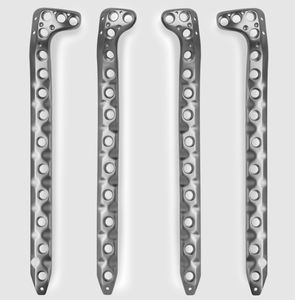
Femoral periprosthetic plate NCB®proximaldistallocking

Add to favorites
Compare this product
Characteristics
- Applications
- femoral periprosthetic fracture
- Part of bone
- distal, proximal
- Locking
- locking
- Materials
- metallic
- Length
115 mm, 401 mm
(4.5 in, 15.8 in)- Number of holes
9 unit, 21 unit
Description
The NCB (Non-Contact Bridging) Periprosthetic Femur System is a line of polyaxial locking plates for the treatment of fractures of the femur, particularly periprosthetic. The system is indicated for temporary internal fixation and stabilisation of fractures and osteotomies of long bones, including: periprosthetic, comminuted and supracondylar fractures, nonunions and malunions and fractures in osteopenic bone.
Features
Non-Contact Bridging
In the locked mode, the NCB Periprosthetic Plate acts as an internal fixator without contact between the plate and the bone surface, which is intended to minimize the risk of periosteal blood supply impairment. This concept can also be controlled specifically through the use of 1, 2, or 3mm spacers, which are threaded into the plate holes prior to plate insertion.
Screw locking is achieved through the use of locking caps that are threaded into the plate holes. This locking construct provides stability, including when used in osteopenic bone.
Bi-Cortical Fixation Around the Prosthesis
Wide plate design in the periprosthetic region, a diagonal three-hole pattern to allow for bi-cortical screw fixation around the prosthesis, and a narrow plate design on the rest of the plate to minimize soft tissue disruption.
Polyaxial Screws
The NCB System Technology allows for polyaxial screw placement (30° cone) with screw locking achieved through the use of locking caps that are threaded into the plate holes. The locking construct allows for improved stability compared to non-locking constructs.
Off-set holes in the three-hole pattern facilitate screw placement around the prosthesis and stable bi-cortical screw fixation.
VIDEO
Catalogs
No catalogs are available for this product.
See all of Zimmer Biomet‘s catalogsRelated Searches
- Bone plate
- Compression plate
- Metallic compression plate
- Locking compression plate
- Titanium compression plate
- Distal compression plate
- Agitator
- Benchtop stirrer
- Proximal compression plate
- Forearm compression plate
- Arthrodesis nail
- Bone substitute
- Tibia compression plate
- Femoral stem
- Radius compression plate
- Blender
- Metallic intramedullary nail
- Non-locking compression plate
- Proximal fixation intramedullary nail
- Knee prosthesis
*Prices are pre-tax. They exclude delivery charges and customs duties and do not include additional charges for installation or activation options. Prices are indicative only and may vary by country, with changes to the cost of raw materials and exchange rates.






